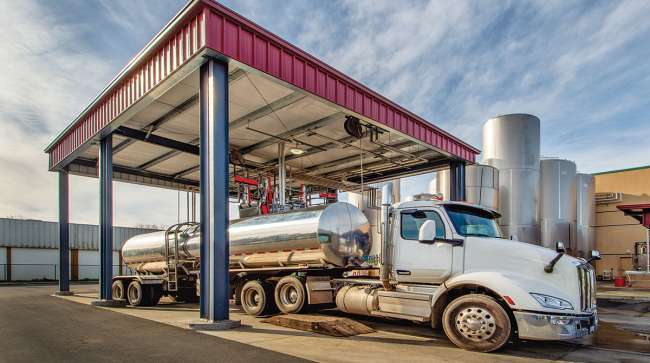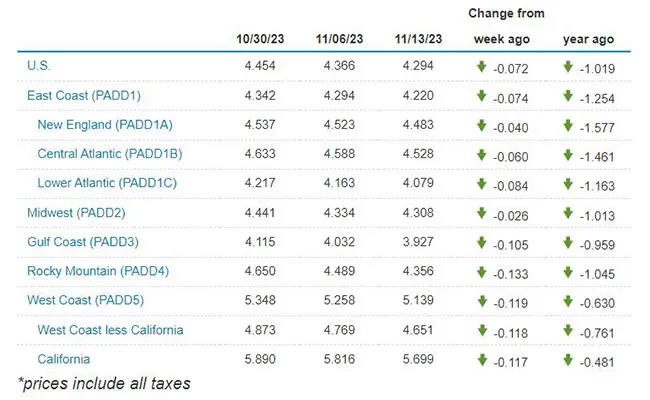Staff Reporter
Diesel Price Drops 7.2¢ a Gallon to Reach $4.294

[Stay on top of transportation news: Get TTNews in your inbox.]
The national average diesel price posted its third straight substantial decline, sliding 7.2 cents to settle at $4.294 a gallon, according to Energy Information Administration data released Nov. 13.
Diesel shrugged off a 10.1-cents-a-gallon gain Oct. 23 to drop a combined 25.1 cents over the past three weeks. A gallon of diesel on average costs $1.019 less than it did at this time a year ago.
The average diesel price fell in all 10 regions in EIA’s weekly survey, with the greatest decrease being 13.3 cents a gallon in the Rocky Mountain area. Four other regions recorded declines of at least 10.5 cents. The smallest drop was 2.6 cents in the Midwest.
The average price for a gallon of gasoline dipped 4.7 cents to $3.349. That's 41.3 cents less than it cost at this time in 2022. It is also 44.9 cents less than a month earlier, encouraging consumption.
U.S. On-Highway Diesel Fuel Prices

Gasoline demand averaged 8.95 million barrels a day in the week that ended Nov. 10, after having averaged 9.49 million barrels a day a week earlier, according to EIA data published Nov. 15. The agency did not publish demand figures for two weeks because of systems upgrades.
Analysts at GasBuddy expected demand of 8.42 million barrels a day and 8.76 million barrels a day, respectively.
The figures were staggering, matching consumption levels typically only seen during the peak summer driving season, Patrick De Haan, head of petroleum analysis for GasBuddy, wrote on X, formerly known as Twitter.
EIA Reports Summer-like Gasoline Demand, Oil Inventories Surge, by @GasBuddyGuy https://t.co/vXTxEW2UT5 — Patrick De Haan (@GasBuddyGuy) November 15, 2023
Meantime, distillate demand on a four-week rolling average was about flat on a year-over-year basis at 4.039 million barrels per day, EIA data show. The last set of data released before the EIA hiatus showed distillate demand — or diesel consumption — down 4.5% year-over-year.
Distillate inventories fell 1.4 million barrels in the week that ended Nov. 10, leaving stocks 13% below the five-year average at 106.6 million barrels, according to EIA. Inventories are 0.7% below the same point a year ago. Distillate stocks fell 3.3 million barrels in the week that ended Nov. 3.
Construction and harvest demand may have offset slightly weaker consumption from the freight segment of the market, said David Thompson, executive vice president at Washington-based brokerage Powerhouse.
That’s partly because October freight shipments fell 9.5% year-over-year, according to the Cass Freight Index, while also declining 4.7% month-on-month.
U.S. average on-highway #diesel fuel price on November 13, 2023 was $4.294/gallon, DOWN 7.2¢/gallon from 10/06/23, DOWN $1.019/gallon from year ago #truckers #shippers #fuelprices https://t.co/lPvRNZFztg pic.twitter.com/R4rcN9FkE0 — EIA (@EIAgov) November 14, 2023
Freight volumes have fallen on a year-over-year basis in 15 of the past 22 months, said Cass Information Systems, which compiles the data for the index. Shipments rose on a monthly basis in the two prior months.
However, the picture may not be altogether so gloomy.
“The peak season is off to a muted start, but we think overall freight volumes are better than those in the for-hire sector measured by Cass data, as private fleet insourcing persists,” it said.
NRF’s new Center for Retail & Consumer Insights launched the CNBC/NRF Retail Monitor, powered by Affinity Solutions, a product that provides accurate and timely insights on retail sales activity. https://t.co/QRPUKSHABD pic.twitter.com/QZD1bI6Hvs — National Retail Federation (@NRFnews) November 13, 2023
National Retail Federation data lends credibility to that perspective. In October, total retail sales, excluding automobiles and gas, were down 0.08% from September and up 2.57% year-over-year, NRF data show. Also, NRF forecasts record holiday sales and year-over-year growth of between 3% and 4%, noting this was in line with pre-pandemic holiday growth rates.
In addition, NRF’s Global Port Tracker expects November imports to increase 5.8% compared with the year-ago period, the first year-over-year gain since June 2022. December imports are expected to rise 6.8% year-on-year.
Some support for the freight market also may be available from consumer demand as the steep ascent in the cost of living is seen to be slowing.
Check out Transport Topics' updated Top 50 list of the largest freight transportation companies in the world and explore how these companies are re-evaluating their supply chains. Tune in above or by going to RoadSigns.ttnews.com.
The Consumer Price Index was unchanged in October from September, according to the U.S. Bureau of Labor Statistics. It was the first month since July 2022 in which the cost of living did not increase. Also, the annual inflation rate cooled to 3.2% in October from 3.7% in September.
A softer CPI could help convince the U.S. Federal Reserve that inflation is in check, encouraging the central bank to hold off on further interest rate increases, which likely would slow the economy.
Economists at ACT Research agree. In a Nov. 3 outlook, they said: “After a long downturn, freight demand fundamentals are improving as pandemic substitution effects fade and disinflation takes hold, improving real incomes.
“Interest rate-sensitive sectors, including housing and manufacturing, face a cautious outlook, but the labor market continues to defy expectations of slowdown, even as wage growth slows, easing inflation pressure.”
Meanwhile, the decline in diesel prices the past six weeks or so may be bottoming out if wholesale futures markets are any indicator. The front-month Nymex ULSD futures contract’s pullback from around $3.50 a gallon in late September could be coming to an end, said Thompson, with support found around $2.80 a gallon in recent days. A close above $2.87-$2.88 a gallon could indicate a change in momentum.
Want more news? Listen to today's daily briefing below or go here for more info:





